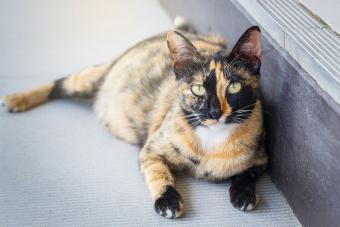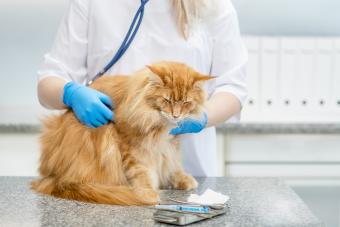
Vomiting is never a normal occurrence for cats and should be investigated to identify the underlying cause. It's important to consider the frequency as well as the type of vomit. Throwing up clear liquid can be triggered by something as simple as excess stomach acid from going too long without food or a more severe reason, such as an intestinal foreign body. If your cat vomits clear liquid, this can indicate a variety of medical issues.
If you're having trouble mapping various cat digestive symptoms and behaviors to possible health problems, you're not alone -- it's difficult. LoveToKnow partnered with a veterinarian to write an eBook all about feline digestive problems and how to remedy them. Grab a copy!
Cat Vomit Appearance
Clear liquid vomit can look exactly as the name implies. It is either a clear liquid or sometimes white foam. You can distinguish this vomit from other types because of the color and because there are no solid items in it, such as cat food, fur, or hair. There are several common reasons a cat may vomit clear liquid. These can include hairballs and mild indigestion from drinking too quickly or not eating enough. More troubling causes for vomiting clear liquid are ingesting toxic substances or serious medical conditions like hyperthyroidism, cancer, diabetes, or kidney disease.
Hairballs
A very common reason for clear liquid vomit is hairballs. When your cat has a hairball and vomits up clear liquid, this is their body's way of trying to expel the hairball out of the stomach. Some gastric liquids may precede the actual hairball coming up. The best way to treat hairballs is to groom your cat regularly to remove excess fur and increase their fiber intake or try a lubricating hairball gel. However, if you notice your cat repeatedly vomiting clear liquid without producing any hairballs, then the reason is likely something else, and a vet visit is warranted.
Indigestion
Cats can vomit foam for a number of stomach upset reasons:
- Not eating enough or waiting too long between meals can make a cat vomit white foam because the cat is hungry and their stomach is producing too much acid. If no food enters the stomach, the acid will irritate your cat's stomach enough to cause vomiting. Feeding your cat several small meals during the day instead of fewer and larger ones can help.
- Eating too quickly or too much can lead to vomit, though you'll usually see the cat's entire meal in their vomit, and not just clear liquid. To prevent this, you can use a slow feeder to keep your cat from eating too fast.
- Changing their type of food can also cause upset and clear vomit if you did not make the change gradually.
- More serious stomach conditions that involve clear or foamy white vomit include gastroenteritis, irritable bowel syndrome, or food allergies. Your veterinarian may prescribe a specific diet for these conditions and further medications if necessary.
- Another form of indigestion that leads to clear vomit is if the cat is experiencing a loss of appetite or nausea due to serious diseases such as cancer, kidney disease, or diabetes.
Ingesting Poison

Ingesting toxins can cause clear liquid and foamy vomit. Common toxic hazards include rodenticides, antifreeze, human medications, toxic foods, and poisonous plants. If you're aware of what your cat has eaten and you know it's poisonous, take your cat to the veterinarian right away. You can also call the ASPCA Poison Control Center Hotline or Pet Poison Helpline to open a case while on your way to the veterinarian's office. Depending on the type of toxin, your veterinarian may attempt to get the cat to vomit or pump their stomach, then give them activated charcoal and IV fluids.
Foreign Objects
Likewise, ingesting a foreign object or material can lead to clear vomit. Even cats who don't typically get into mischief can unintentionally swallow a hair tie, small toy, rubber band, or a piece of yarn while playing. When the object can't pass through the pylorus or intestines, it can cause a blockage that may require surgery to remove. In addition to vomiting, other symptoms include lethargy, inappetence, abdominal discomfort, and lack of feces. Your veterinarian will recommend x-rays to determine where the object is and discuss treatment options with you.
Hyperthyroidism
Clear vomit may also indicate your cat has hyperthyroidism. This condition tends to happen in older cats, as the average recorded age is 13 years old, although it can sometimes occur in younger cats. Along with the vomiting, you may see symptoms such as weight loss accompanied by excessive eating and thirst, as well as hyperactivity, diarrhea, and losing hair. Treatment may involve long term medication or radioactive iodine therapy.
Constipation
When a cat becomes moderately or severely backed up with stool, they often experience nausea and will vomit. Many constipated cats do not have an appetite due to this nausea, so their vomit may be clear liquid rather than containing food. If your cat is straining to defecate without producing stool or producing a very small amount, this could be the case. The goal when treating constipation is to aid in moving the feces through and out of the colon, which can involve laxatives, enemas, or manual extraction by a veterinarian. However, feline constipation can have a number of underlying causes, so it's important to address the root problem.
Caring for Your Vomiting Cat
While a common cause for clear liquid or foamy vomit is hairballs, frequent episodes of vomiting may indicate your cat has a more serious condition. Always monitor your cat and contact a veterinarian right away if your cat does not produce any hairballs, and the vomiting continues for more than 24 hours. It's also important to seek urgent care if you notice any other concerning signs, such as appetite loss, diarrhea, inability to pass stool, belly pain, weakness, or collapse.







